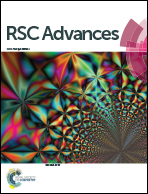Nano-scale morphological analysis of graphene–rubber composites using 3D transmission electron microscopy†
Abstract
In this work three-dimensional transmission electron microscopy (3D-TEM) is exploited to characterize a soft graphene based nano-composites structure and the constituted morphology in a qualitative way. The reconstruction of the two dimensional slides into a three dimensional tomographic image is a powerful tool, when the images of the nano-object are reflected into a quasi-distinguishable object due to superposition effect. By using this technique it is possible to mark the contour area of the nano-sized object inside the soft rubber matrix. To extract information about the filler network, the clustering process of the fillers or the existence of single or multiple graphene sheets, a solution polymerised styrene butadiene rubber was selected as a soft matrix which was filled with carbon black (CB) and graphene nano-platelets (GnP). The dispersion/exfoliation of the stacked graphene sheets into individual single sheets was facilitated by the presence of carbon black in the system as understood from TEM, X-ray diffraction and Raman spectroscopic studies. The existence of oligo-layer graphene sheets was detected by this 3D-TEM, especially when the rubber matrix exists in a complex morphology arisen from filler–filler networks in all spatial dimensions.


 Please wait while we load your content...
Please wait while we load your content...